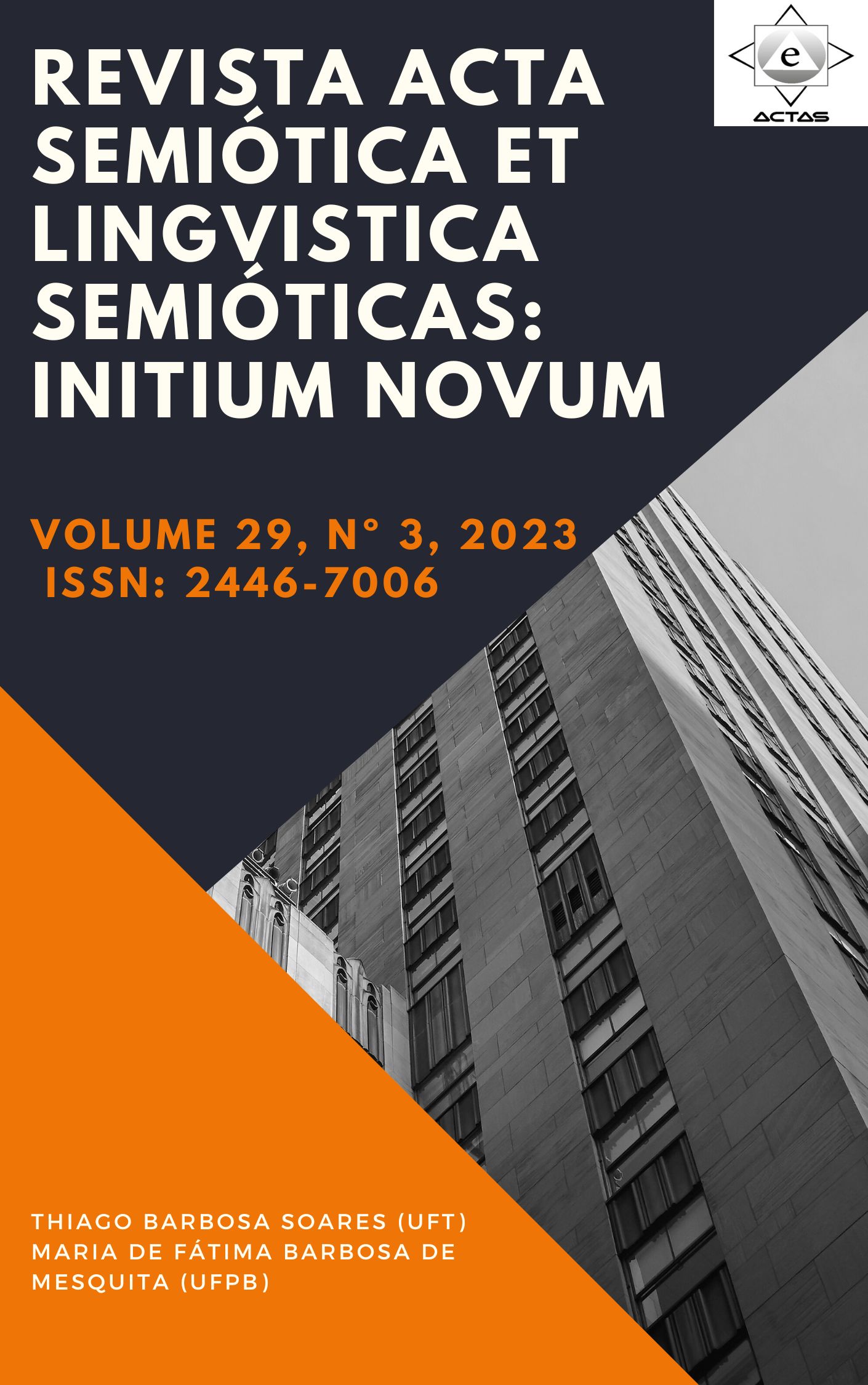Linguagem, Sentido e Cognição
DOI:
https://doi.org/10.20873/actasemiticaetlingvistica.v29i3.18038Keywords:
Linguística, Linguística Cognitiva, Sociologia CognitivaAbstract
Nosso objetivo com essa proposta é desenvolver um estudo voltado para a atitude e a percepção do ouvinte em relação a questões que foram introduzidas em um instrumento aplicado a diferentes falantes de todo o Brasil, a ser detalhado na seção Metodologia. O suporte teórico a ser utilizado é o da Linguística Cognitiva associada à Sociolinguística Cognitiva. Este plano está assim estruturado: na seção 1, introduzimos, teoricamente, o desenvolvimento dos estudos linguísticos até a emergência da Sociolinguística Cognitiva; na seção 2, apresentamos um esboço sobre a Linguística Cognitiva, seguido na seção 3 por informações sobre a Sociolinguística Cognitiva; na seção 4, tecemos considerações sobre Cognição e Atitude; na seção 5, detalhamos alguns conceitos relacionados à Percepção; na seção 6, discorremos sobre a Metodologia que norteou a coleta de dados; e, na seção 7, as Referências.
References
ALLPORT, G. Attitudes. In: MURCHISON, C. (ed.). A handbook of social psychology (vol. II). Worcester: Clark University Press, 1935.
ALLPORT, G. The historical background of modern social psychology. In: LINDZEY, G. (ed.). Handbook of social psychology: theory and method (vol. I). Cambridge: Assison- Wesley, 1954, p. 3-56.
AMARAL, Amadeu. O dialeto caipira. 2. ed. São Paulo: HUICITEC; Secretaria de Ciência e Tecnologia, 1976.
BYBEE, Joan; HOPPER, Paul. Frequency and the Emergence of Linguistic Structure. Amsterdam: John Benjamins, 2001.
CHOMSKY, Noam e HALLE, Morris. The sound pattern of English. New York: Harper e Row, 1968.
CLOPPER, Cynthia G.; PISONI, David B. Perception of dialect variation. In: PISONI, David B.; REMEZ, Robert E. The handbook of speech perception. Oxford: Blackwell Publishing, 2005.
CROFT, William. Toward a social cognitive linguistics. In: Vyvyan Evans & Stéphanie Pourcel (eds.), New Directions in Cognitive Linguistics. Amsterdam: John Benjamins, 395-420, 2009.
FARACO, Carlos Alberto. Linguística histórica. São Paulo: Parábola, 2005.
GAERAERTS, Dirk; KRISTIANSEN, Geet; PEIRSMAN, Yves. Advances in cognitive sociolinguistics. Berlin / New York: Mouton de Gruyter, 2010.
GARRET, Peter; COUPLAND, Nikolas; WILLIAMS, Angie. Investigating language attitudes: social meanings of dialect, ethnicity and performance. Cardiff: University of Wales Press, 2003.
GUY, Gregory R. Sociolinguistics and formal linguistics. In: WODAK, Ruth; JOHNSTONE, Barbara; KERSWILL, Paul. The Sage Handbook of Sociolinguistics. London: SAGE Publications Ltd., 2010.
HARDER, Peter. The status of linguistic facts: Rethinking the relation between cognition, social institution and utterance from a functional point of view. Mind and Language 18: 52-76, 2003.
ITKONEN, Esa. What is Language? A Study in the Philosophy of Linguistics. Turku: , Åbo Akademis tryckeri. 2003.
KEEMER, Suzanne; BARLOW, Michael. Introduction. In Usage-Based Models of Language, Michael Barlow and Suzanne Kemmer (eds.), vii–xxviii. Stanford: CSLI Publications.
KLATT, D. H. Review of sected models of speech perception. In: MARSLEN-WILSON, W. (ed.). Lexical representation and process. Cambridge: MA – MIT, 1989.
KRISTIANSEN, Gitte How to do things with allophones: Linguistic stereotypes as cogni- tive reference points in social cognition. In: Rene ́ Dirven, Martin Pütz and Roslyn Frank (eds.), Cognitive Models in Language and Thought. CLR 24, 69120. Berlin/New York: Mouton de Gruyter, 2003.
KRISTIANSEN, Gitte et al. Cognitive Sociolinguistics Revisited. Berlin: De Gruyter Mouton, 2021.
LABOV, William. Principles of languistic change. Vol. 3: cognitive and cultural factors. United Kingdon: Wiley-Blackwell, 2010.
LABOV, William. The Social Stratification of English in New York City. 2. ed. Washington, D.C.: Center for Applied Linguistics, 1966.
LAKOFF, G. Cognitive Phonology. In: GOLDSMITH, J. (Ed.). The last phonological rule: reflections on constraints and derivations. Chicago/London: University of Chicago Press, 1993. p. 117-145.
LAKOFF, G. Women, fire, and dangerous things: what categories reveal about the mind.
Chicago: The University of Chicago Press, 1987.
LANGACKER, Ronald W. Foundations of cognitive grammar: theoretical prerequisites. v. 1. Stanford: Stanford University Press, 1987.
LANGACKER, Ronald W. A dynamic usage-based model. In Grammar and Conceptualization, Ronald W. Langacker, 91-145. Berlin/New York: Mouton de Gruyter, 1999.
MARROQUIM, Mário. A língua do Nordeste – Alagoas e Pernambuco. Curitiba: HDLivros, 1996.
MEILLET, Antoine. Linguistique historique et linguistique générale. Paris: Librairie Ancienne Honoré Champion Éditeur, 1948 [1912].
NASCENTES, Antenor. O linguajar carioca. 2. ed. Rio de Janeiro: Simões, 1953.
OPPENHEIM, B. A exercise in attitude measurement. In G.M. Breakwell, H. Foot & R. Gilmour (eds.). Social Psychology: A Practical Manual. London: Macmillan Press, 1982.
OSTHOFF, Hermann; BRUGMANN, Karl. Preface to “Morphological investigations in the sphere of the indo-european languages I”. In: LEHMANN, Winfre (org.). A reader in nineteenth-century historical indo-european linguistics. Bloomington, London: Indiana University Press, 1967, cap. 14, p. 197-209.
PAUL, Hermann. Princípios fundamentais da história da língua. Lisboa: Fundação Calouste Gulbenkian, 1983, p. 59-130.
R CORE TEAM. R: A language and environment for statistical computing. R Foundation for Statistical Computing, Vienna, Austria, 2019.
RSTUDIO TEAM. RStudio: Integrated Development Environment for R. Boston, MA, 2018. URL: <http://www.rstudio.com/>.
SARNOFF, I. Social attitudes and resolution of older and younger adult speakers: the influence of communication effectiveness and noise. Psychology and Aging, 5, p. 514- 519, 1970.
SAUSSURE, Ferdinand de. Curso de linguística geral. São Paulo: Cultrix, 2006.
SCHUCHARDT, Hugo. Ueber die Lautgesetze. Gegen die Junggrammatiker. Berlin: Oppenheim, 1885.
SINHA, Chris. Cognitive linguistics, psychology and cognitive science. In: Dirk Geeraerts & Hubert Cuyckens (eds.), Handbook of Cognitive Linguistics, New York: Oxford University Press, 1266-1294, 2007.
SOARES DA SILVA, Augusto. A Sociolinguística Cognitiva: razões e escopo de uma nova área de investigação linguística. Revista Portuguesa de Humanidades – Estudos Linguísticos 13-1, 2009, pp. 191-212.
TOMASELLO, Michael. Constructing a Language: A Usage-Based Theory of Language Acquisition. Cambridge: Harvard University Press, 2003.
THURSTONE, L. The measurement of scoial attitudes. Journal of abnormal and social psychology, 26, p. 249-269, 1931.
VENHAGEN, Urie. Constructions of Intersubjectivity: Discourse, Syntax, and Cognition. Oxford: Oxford University Press, 2005.
VENHAGEN, Urie; VAN DE WEIJER. Jeroen. Introduction. In Usage-Based Approaches to Dutch, Arie Verhagen and Jeroen van de Weijer (eds.), 1–6. Utrecht: LOT, 2003.
ZLATEV, Jordan. hat's in a schema? Bodily Mimesis and the grounding of language. In From Perception to Meaning: Image Schemas in Cognitive Linguistics, Beate Hampe (ed.), 313-342. Berlin/New York: Mouton de Gruyter. 2005.





